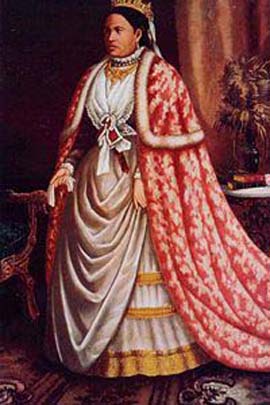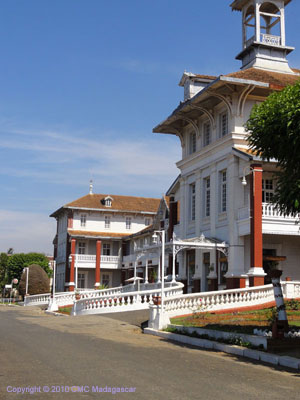













|
| Queen Ranavalona II |
Chantal RADIMILAHY
Ethnologist, Lecturer at the University of Antananarivo
Madagascar Fenêtres vol 3 Ed Cite, Ambatonakanga, Antananarivo
The name «Antsirabe», current chief town of the Vakinankaratra Region, comes from the term «Any-sira-be» which literally translates as «where salt abounds» And later, the term has morphologically become «Antsirabe».
A first explanation is that the origin of the name of the city of Antsirabe comes from the abundance of thermal waters that taste rather salty. This is the opinion most disclosed by the guidance books.
However, a second interpretation is more plausible: the rock salt was exploited in the past in a locality south of the current city of Antsirabe. The growing production of rock salt has given the city its name.
In 1869, Pastor BORGEN was the first foreign resident in the Region. The latter invested in the construction of the bases of the future city. Among the achievements, we can mention the construction of hard houses, the supply of drinking water, the discovery and exploitation of thermal waters, the improvement of the living conditions of the condemned and their progressive emancipation.
On 05 July 1903, Antsirabe became Chief Town of Vakinankaratra. This date marked the beginning of the city’s development and equipment works: the baths, the station, the post office, the gardens and all the colonnaded buildings still visible today. Under the governorate of Gallieni from 1896 to 1905, Augagneur from 1905 to 1910, Picquie from 1910 to 1914 and Garbit from 1914 to 1924, the city was the realization of the dream of the French : a center of rest and leisure.
 |
| L'Hôtel des Thermes from Antsirabe |
In 1953, the king of Morocco, deposed by the French, spent a few years in exile in the prestigious Hôtel des Thermes. Finally returning to Morocco in 1955, he obtained independence a few months later. Antsirabe remembers his young son then aged 25 who will be called to rule under the name of Hassan II.
It should be remembered that the queen of Madagascar, Ranavalona III was also exiled to Algiers in 1897.
Note also that the President of the First Republic, Philibert Tsiranana, often came to rest there on weekends ; Former President of Bukina Faso, Thomas Sankara, studied there at the Military Academy of Antsirabe.